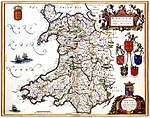Wales in the High Middle Ages
Wales in the High Middle Ages covers the 11th to 13th centuries in Welsh history. Beginning shortly before the Norman invasion of the 1060s and ending with the Conquest of Wales by Edward I between 1278 and 1283, it was a period of significant political, cultural and social change for the country.
Part of a series on the |
|---|
| History of Wales |
 |
|
Chronology |
|
|
.svg.png)
End of the first millennium
By the later centuries of the first millennium, according to Wendy Davies, a clearer pattern of development is seen, and the expansion and subsequent domination of the Welsh Kingdom of Gwynedd, a province of north-west Wales, is fairly well-established. The aforementioned kingdoms of the south-east seem to have remained relatively isolated until the eleventh century (102).
Throughout this period, the English Saxons exerted some influence over Wales, if only by settlement at times. In the sixth century, the Saxons appear to have attacked Wales; however, "relations between the English and the British of Wales were not entirely hostile" after these attacks (W. Davies, 113). For some 200 years starting in the seventh century, from the establishment of Mercia, there were sporadic raids and skirmishes in both Wales and England, perpetrated by both powers.
With the later establishment of a legitimate English monarchy, the southern Welsh kingdoms sought out King Alfred’s protection against the kings of Gwynedd, and "they thus accepted Alfred’s lordship … in so doing" (114). Throughout the tenth century, Davies says, "ravagings went on," in Gwynedd, the south-east, in Dyfed, and often perpetrated by Mercian kings, all this despite courtly appearances of friendship. Further, some Welsh kings had the foresight to turn the English to their own purposes, forging alliances against other Welsh kings, using the English as a source of soldiers and tactics, thus "end[ing] the hard lines of cultural separation" between England and Wales (115).
Bibliography
- Davies, R. R. (2000). The Age of Conquest: Wales 1063–1415. Oxford University Press. ISBN 0-19-820878-2.CS1 maint: ref=harv (link)
- Davies, John (2007). A History of Wales. Penguin Books Limited. ISBN 978-0-14-192633-9.CS1 maint: ref=harv (link)
- Moore, David (2013). The Welsh Wars of Independence. History Press Limited. ISBN 978-0-7524-9648-1.CS1 maint: ref=harv (link)
- Walker, David (1990). Medieval Wales. Cambridge University Press. ISBN 978-0-521-31153-3.CS1 maint: ref=harv (link)
